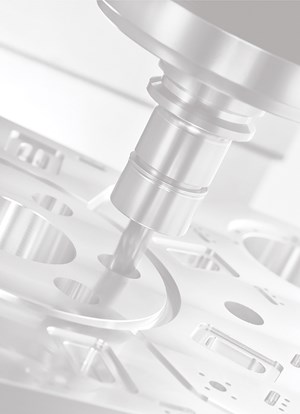Closing the Loop for Better Gaging
Gages and measuring instruments come in different shapes and sizes. Whether it be a snap gage, a bench stand, a surface-finish gage or even a form system, keeping the “measuring loop” as small or as short as possible is important for better gage performance.
Share



Most dimensional gages have some type of reference, which is the part of the gage that provides a hard stop and is the starting point from which the dimensional measurement is taken. For example, on a snap gage or bench stand, the reference is usually called a fixed or reference anvil since it tends to be flat. The reference point is where the measurement is started, and every contact gaging system has one.
Speed and increased performance requirements might necessitate the use of a comparative gage. In this case, another reference may be added. This helps eliminate both operator and gage variability errors, improving gage repeatability.
Directly opposite, and in line with the reference anvil, is the measuring instrument’s sensitive contact. This is the mechanism that does the actual comparative or direct sensing of the contact’s position. Take the case of a bench stand with a dial indicator: The contact — usually having a radius — is the actual tip of the indicator. For a micrometer, it's the sensitive anvil, and with a dial caliper, it's the sensitive jaw. But the message is that this sensing contact is the point that is really “feeling” the measurement.
In the fixed-reference anvil, the sensitive contact and backstop just can't live by themselves. They must be held together by the gage itself, and this is where our measuring loop comes into play. With a snap gage, it is the frame, reference(s) and indication device. A bench stand may have the base, post, an arm and indicating device
In these examples, the whole structure makes up the measuring loop. To get the best performance out of the measuring loop, keep it as small as possible along with being rigid and robust. For example, to make a length check on a part smaller than 10 mm, choose the smallest and most robust bench stand that has the capacity for this part. The larger a bench stand gets, the more “spring” or deflection might be seen in the posts and arms of the gage. Choosing a larger gage, say 10 times the capacity, would increase the measuring loop and potentially increase the chances of variation in part measurement due to flexing in the measuring loop.
As mentioned in the beginning, this not only applies to mechanical gaging but also surface and form measurement.
In the case of a skidded surface measurement, the sensitive contact now becomes the surface finish probe and its drive. The reference is the skidded probe and the measuring loop is created by the fixturing holding everything together. In most cases, the drive unit/probe can be directly placed on the part for the shortest measuring loop possible. However, sometimes certain applications call for measuring surfaces in deep bores. One solution for doing this would be to keep the drive outside the bore and use probe extensions to position the probe deep into the bore. But this, in effect, makes the measuring loop larger, opening the door for vibration and fixturing issues that can negatively influence the results. When possible, it would be best to position the drive and probe into the bore with special fixturing to close the loop and improve the results.
Finally, there are some form systems that have small part measuring capacities and others in which small- and large-volume parts can be measured. Certainly, the large systems have much more robust columns and arms employed. This is designed into the gage to account for both small and large measuring loops. For the best performance (since one can’t shrink the loop) the components in the loop must be made robust enough to produce the same performance for both small and large parts.
After reading this, the next time you look at your measuring and gaging instruments, you will have new insight into finding the measuring loop.
Related Content
Understanding New Surface and Profile Standards
Standards for surface finishes and profiles are not static; they change as technology changes or new processes come along that need to be considered.
Read MoreOrthopedic Event Discusses Manufacturing Strategies
At the seminar, representatives from multiple companies discussed strategies for making orthopedic devices accurately and efficiently.
Read MoreMarathon Precision’s Engineering Playground: One Shop’s Secret to Sustaining High Tech, Low-Volume and High Morale
Half an airplane on the wall, a ten-foot metal dragon, and a full-blown recording studio might not scream “manufacturing efficiency,” yet Marathon Precision proves otherwise. Here’s how forging, complex CNC operations and staff-driven creative projects combine to fuel the shop’s productivity and profitability.
Read MoreMachined Part Geometry Measurement
Uncertain about uncertainty? Having trouble remembering the difference between accuracy and precision? Read on to review key metrology terms relevant to the ISO Guide to the Expression of Uncertainty in Measurement (ISO GUM).
Read MoreRead Next
OEM Tour Video: Lean Manufacturing for Measurement and Metrology
How can a facility that requires manual work for some long-standing parts be made more efficient? Join us as we look inside The L. S. Starrett Company’s headquarters in Athol, Massachusetts, and see how this long-established OEM is updating its processes.
Read More



















 (1).png;maxWidth=300;quality=90)






